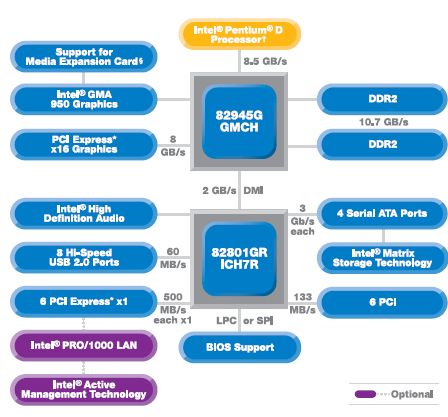Chipset discussion
A look at the i945-series with the help of the ubiquitous chipset block diagram.
Taking it from the top, there's two i945-based chipsets. The first is the one you see in the block diagram above, the i945G, which integrates Intel's GMA 950 onboard graphics on to the northbridge. The second is a standalone version, the i945P, which only differs by doing away with the GMA 950. Coming back to the i945G, it supports all LGA775 CPUs to date. That runs from relatively cheap Celeron Ds through to the uber-expensive Pentium XE 840, so it's support for CPUs with 533MHz, 800MHz and 1066MHz system bus speeds and, importantly, for the new wave of dual-core CPUs. The i955X Express, incidentally, doesn't support 533MHz system bus processors.
Official memory support stands at dual-channel DDR2-667 speeds, offering, theoretically, up to 10.7GB/s of juicy bandwidth. Maximum RAM will be limited to 4GB (as opposed to the i955X Express' 8GB) and there's no provision for ECC support. Remember that the 82945G northbridge will be a touch slower than the 82955X's, thanks to a lack of memory access optimisation. Manufacturers may well find a way around this problem; ASUS being one of the best for enabling what amounts to the i955X Express' Memory Pipeline Technology. I'd usually point out that 10.7GB/s memory bandwidth is wasted when most LGA775 CPUs run off an 800MHz system bus and therefore can only make do with 6.4GB/s. However, with onboard graphics leeching bandwidth from the system's, more is always going to be better.
The incumbent GMA 900 was no great shakes when it came to playing the latest games. Its 333MHz-rated core speed was allied to 4 pixel pipelines, capable of a multi-texturing fillrate of around 1.3GTexels/s. It also supported DX9 acceleration for pixel and vertex shaders, although the latter was done via software. Dynamically allocated memory bandwidth kept systems with <512MB RAM chugging along. Performance-wise, the GMA 950 is more of the same. Intel's boosted the core speed up to 400MHz, offering up to 1.6GTexels/s throughput, and Pixel Shader 2.0 is still done in hardware. Vertex Shader 3.0 and Transform and Lighting (T&L) is, unfortunately, left in software. You've got to save costs somehow. right?. The GMA 950 supports Media Expansion Cards, which allow one to add a TV tuner or multi-display capability. All the common outputs are supported, including regular VGA, HDTV, DVI-I and TV-Out. Of course, you can bypass the GMA 950 and opt for a discrete PCI-Express-based card.
Looking on down, Intel and its partners will offer the i945G with one of two southbridge flavours. ICH7 is the basic, no-frills partner. It offers 4 PCI-Express x1 lanes that can be combined to form a single x4 port. Its integrated SATA controller feeds on to 4 ports for transfer speeds of up to 3Gb/s (300MB/s). It also provides for 8 USB2.0 ports, 6 PCI, and optional Intel Gigabit LAN. The ICH7R, though, is more than just a RAID version of the ICH7. It adds in a further two PCI-Express x1 lanes, AHCI (hot-plugging capability, hardware-assisted NCQ) and, of course, Matrix Storage Technology, which offers RAID0, 1, 5, and 10 modes, as well as multiple RAIDs on two disks. High-Definition Audio is present on both southbridges and is a decent improvement over basic AC'97.
The i945G, then, takes most of the i955X Express feature-set and adds in integrated graphics. If the 82945G/82945P are paired up with the ICH7R, which I presume will be the case for the majority of retail boards, there's scant little to choose between them and the premier chipset, save for tighter memory timings and SLI performance.









